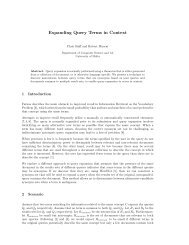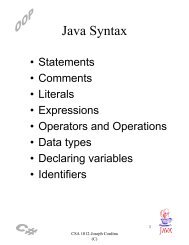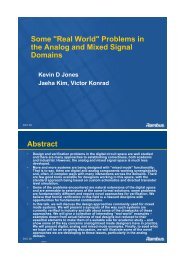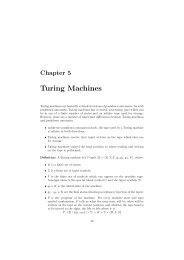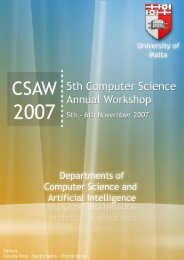Proceedings of CSAW'04 - FTP Directory Listing - University of Malta
Proceedings of CSAW'04 - FTP Directory Listing - University of Malta
Proceedings of CSAW'04 - FTP Directory Listing - University of Malta
You also want an ePaper? Increase the reach of your titles
YUMPU automatically turns print PDFs into web optimized ePapers that Google loves.
Forecasting Using Non-Linear Techniques In Time Series<br />
Analysis: An Overview Of Techniques and Main Issues<br />
Michel Camilleri<br />
Department <strong>of</strong> Computer Science and AI,<br />
<strong>University</strong> <strong>of</strong> <strong>Malta</strong><br />
Abstract. The development <strong>of</strong> techniques in non linear time series analysis has emerged<br />
from its time series background and developed over the last few decades into a range <strong>of</strong><br />
techniques which aim to fill a gap in the ability to model and forecast certain types <strong>of</strong><br />
data sets such a chaotic determinate systems. These systems are found in many diverse<br />
areas <strong>of</strong> natural and human spheres. This study outlines the background within which these<br />
techniques developed, the fundamental elements on which they are based and details some<br />
<strong>of</strong> the predictive techniques. This study aims to provide some insight into their mechanisms<br />
and their potential.<br />
1 Introduction: The Need for Forecasting<br />
No one knows the future, but there is a lot <strong>of</strong> benefit to be derived from attempting to form a<br />
picture <strong>of</strong> what the future could be - even if it is imprecise. It is one <strong>of</strong> the task most decision<br />
makers are expected asked to do - from the hunter-farmers <strong>of</strong> prehistoric age to the stock analysts<br />
<strong>of</strong> today.<br />
[1] Almost all managerial decisions are based on forecasts. Every decision becomes operational at<br />
some point in the future, so it should be based on forecasts <strong>of</strong> future conditions.<br />
A significant amount <strong>of</strong> research has been carried out using time series techniques in such diverse<br />
fields as [13] modelling and predicting solar sun spot activity, [5] analysis <strong>of</strong> Ethernet traffic,<br />
Business cycles, [3] Intelligent analysis <strong>of</strong> clinical time series in Diabetes Mellitus. Non linear techniques<br />
are emerging as powerful tool in the hands <strong>of</strong> the analyst to leverage patterns <strong>of</strong> behaviour<br />
underlying hiding dynamical systems - which may elude analysis using other traditional techniques.<br />
[1] A model is an external and explicit representation <strong>of</strong> a part <strong>of</strong> reality as it is seen by individuals<br />
who wish to use this model to understand, change, manage and control that part <strong>of</strong> reality. Analysts<br />
try to model the system or process which is being studied in a variety <strong>of</strong> ways.<br />
Regression Is the study <strong>of</strong> relationships among variables, a principle purpose <strong>of</strong> which is to predict,<br />
estimate the value <strong>of</strong> one variable from known or assumed values <strong>of</strong> other variables related to it.<br />
Using one predictor it is called simple linear regression. Using two or more predictors, multiple<br />
regression analysis is employed<br />
A Scatter diagram is a graphical representation <strong>of</strong> the pairs <strong>of</strong> data to gain an overall view <strong>of</strong><br />
the problem — is there an apparent relationship Direct, inverse If the points lie within a band<br />
described by parallel lines we can say there is a linear relationship between the pair <strong>of</strong> x and y<br />
values. If the rate <strong>of</strong> change is generally not constant then the relationship is curvilinear.<br />
Linear Models: One would determine if a linear relationship exists between t and y and then<br />
attempt to produce a linear equation stating y as a function <strong>of</strong> x in the form <strong>of</strong> y = a + bx + e



